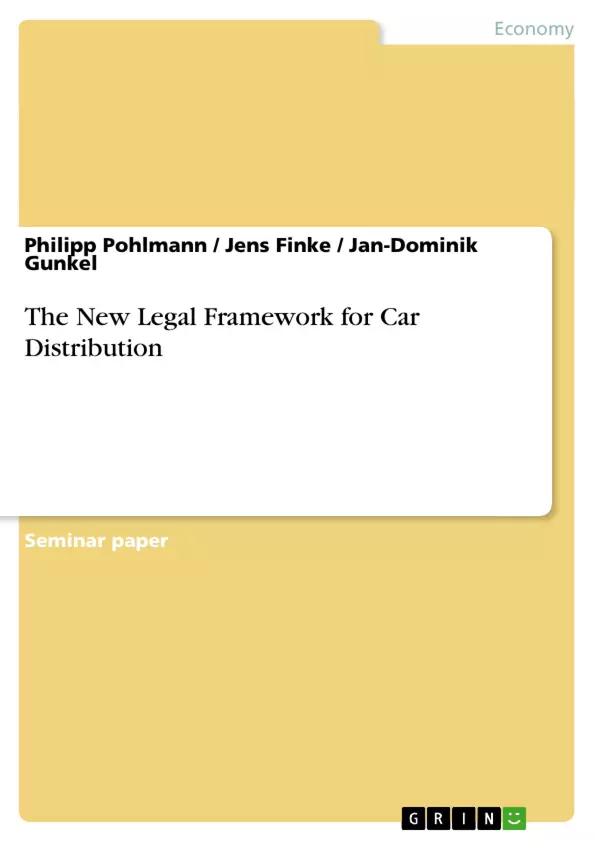The present paper discusses the new legal framework for the automotive distribution, which has been set by regulation 1400/2002 of the European Commission, and clarifies the underlying rationale of this so-called block exemption. To this end, the relevant market has been analysed along the structure conduct performance paradigm. Additionally, the existing trends, e. g. the changing consumer preferences, the changing technological standards, and an increasing number of independent service chains, were investigated to integrate the dynamics into the model. In this context the meaning and the impact of the regulation have been detailed with respect to consumer welfare.The analyses have shown that the new regulation complies with the guiding principles of competition policy and thus fosters competition in the industry. This stands in contrast to its predecessors, which were influenced by lobbying of the car industry and had thus laid the foundation for a heavily regulated business. As shown in this paper, a leap towards increased consumer welfare has been made by weakening the market power of the industry. Among others, the separation of sales and services, the permission of multi-brand outlets and the ban of price discrimination can be named as examples for reforms brought forward in the regulation. Furthermore, the so-called location clause will be abolished as of October 2005, which means that dealerships are allowed to open new outlets anywhere in the common market without the consent of the manufacturer. However, in the course of disallowing vertical restraints, of which some had previously helped to secure efficiencies in the value chain, a relative welfare loss has also developed. For instance, the increased free-riding issues could inspire a development to the detriment of the consumer and the convergence of prices at a high level could be disadvantageous to consumers in low income member states.
Although the regulation has already come a far way, the critique that is voiced at the end of this paper, shows that there is significant room for improvement, once the regulation expires in 2010. Key points are the price convergence towards the level of the high price countries, some inconsistencies in the regulation and a possible loss of intangible consumer welfare. In the end whether the additional welfare surplus outweighs the new welfare loss has to be decided on a per country basis.
Inhaltsverzeichnis (Table of Contents)
- Executive Summary
- Introduction
- The Car Industry Before 2002
- Car Distribution
- IO Analysis of the European Car Industry
- Trends in the Car Industry
- EU Competition Policy with Regard to the Car Distribution
- General Motivation of Competition Policy
- Vertical Restraints and Recommendations from Theory
- The Evolution of the Regulatory Framework for Car Distribution
- Motivation of the New Regulation
- The Regulation 1400/2002
- Process of the Analyses
- Definition of the distribution systems
- Analyses of Articles
- Article 2-Scope
- Article 3 - General Conditions
- Article 4 Hardcore Restrictions
- Article 5-Specific Conditions
- Article 6 - Withdrawal of the Benefit of the Regulation
- Status of the Implementation
- Market Outcome and Critique
- Market Outcome
- Critique
- Price Convergence
- Cost Increase
- Loss of Intangible Consumer Welfare
- Consumer Preferences towards Car Distribution
- Inconsistencies in the New Regulation
- Exemption from the Regulation: de Minimis Rule
- Conclusion
Zielsetzung und Themenschwerpunkte (Objectives and Key Themes)
This paper examines the new legal framework for car distribution in Europe, focusing on the impact of Regulation 1400/2002 on the automotive industry. The analysis considers the motivations behind the regulation, its implications for competition, and the potential consequences for both consumers and producers.
- EU competition policy and its application to vertical restraints in the automotive industry
- The impact of Regulation 1400/2002 on car distribution systems
- The market outcomes following the implementation of the new regulation
- Critical analysis of the regulation's effectiveness and potential unintended consequences
- The evolving dynamics of the European car industry in the context of competition policy
Zusammenfassung der Kapitel (Chapter Summaries)
The paper begins by introducing the car industry's landscape before 2002, highlighting the existing distribution system and its challenges. It then dives into the EU competition policy framework for vertical restraints, examining the regulatory evolution and the rationale behind the new regulation. Chapter 4 delves into the details of Regulation 1400/2002, analyzing its scope, general conditions, and specific restrictions. The following chapter explores the market outcomes after the regulation's implementation, examining price convergence, cost increases, and potential impacts on consumer welfare. The paper concludes by presenting a critical analysis of the regulation and its potential shortcomings.
Schlüsselwörter (Keywords)
The core concepts of this paper revolve around the European automotive industry, competition policy, vertical restraints, and the implementation of Regulation 1400/2002. Key terms include car distribution, market structure, price competition, consumer welfare, and the impact of regulation on market dynamics. The paper explores the interplay of these concepts in shaping the European automotive landscape.
- Citation du texte
- Philipp Pohlmann (Auteur), Jens Finke (Auteur), Jan-Dominik Gunkel (Auteur), 2004, The New Legal Framework for Car Distribution, Munich, GRIN Verlag, https://www.grin.com/document/39526



